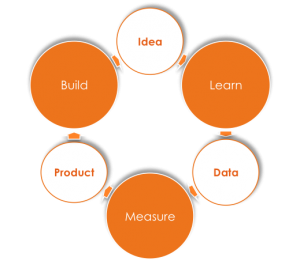Why many cities are zombies (and how Lean Placemaking™ can bring them back to life)
Cities have a lot in common with startups:
- The majority of cities are increasingly bootstrapping
- Nearly all have limited resources and yet have seemingly endless responsibilities and goals to accomplish.
- Many have failed or are failing, relative to meeting their established missions
- But perhaps more precisely, and more distressingly, many cities are effectively “zombies” – not the revolting, mindless corpses kind depicted in Night of the Living Dead (or in less dated terms, Zombie Apocalypse), but the startup kind – “an organization or company that’s operating, but not growing;" one that is "in a state of limbo: not dead, yet not exactly alive.”
A key difference, however, is that in light of their high failure rate, many startups have pivoted (more on that term in the next blog), adopting a fundamentally different business development method – the Lean Startup Methodology. Sparked in large part by Steve Blank’s Four Steps to the Epiphany and Eric Ries’ The Lean Startup, this movement has become absolutely infectious, in a good way! Based on Eventbrite data, the number of registrants of the annual lean startup conference went up by 51% from 2012 to 2013; there are over 1350 lean startup Meetup groups with a total of nearly 350k members in over 460 cities across 70 countries; and over 80k members are part of the Lean Startup Circle, a global grassroots organization of Lean Startup practitioners!
It’s time for the lean startup epidemic to spread to Cities. It's time for Lean Placemaking™.
This blog series will explore why and how lean startup for cities – or Lean Placemaking™ – should be used to disrupt cities’ status quo, the same way lean startup has done for startups. I aim to build upon previous writings on this topic by laying out a parallel structure that cities can use to integrate a lean startup approach – in other words, to outline a Lean Placemaking™ framework, which integrates some of the principles espoused by DIY urbanism, tactical urbanism, pop-up urbanism, and lighter, quicker, cheaper strategic approaches. (Note that Lean Placemaking™ is not the same as what has been recently coined as lean urbanism.)
Before I define the term lean startup, and lay out its methodology’s key tenets, let’s walk through what the typical startup development process has been like historically: 1. Get a brilliant idea 2. Run numbers/Craft a business plan 3. Convince others to give you money for the idea 4. Spend (too much) time building out the product (e.g. technology, infrastructure, design, etc.) to bring the idea to life 5. Market to customers 6. [Try to] sell idea 7. Sell too few ideas 8. Idea (startup) dies, 9 out of 10 times
Now, let’s walk through what the typical city/planning process has been like historically: 1. Get a brilliant idea 2. Run numbers/Craft a conceptual plan, master plan, comprehensive plan, RFP [insert planning mechanism here], etc. 3. Convince others to give you money for the idea/Budget for the idea 4. Spend (too much) time building out the product (e.g. infrastructure, real estate development project, design, etc.) bringing the idea to life 5. Present idea to public/Engage public 6. [Try to] sell idea 7. Sell too few ideas/Face public resistance 8. Idea dies/Idea gets implemented but fails (to meet expectations)
That’s quite the stark parallel, right? I swear it even surprised me as I was writing this out! It’s no wonder why this typical top-down, insular process fails (or dissatisfies) so often. It’s broken.
So what is the lean startup solution to this problem? Actually, one of lean startup’s most significant contributions has been to diagnose the root cause of the problem: The biggest reason for #8 is the fact that #5 is #5 and not #2, or ideally, #1; it’s just too late in the game to bring in the "customer" - or the public. This process increases the likelihood that a startup will fail, and worse, that the startup fails late in the game, after a lot of time and money has been spent on the process and/or product.
The solution then – the Lean Startup – is to implement a “scientific approach to creating and managing startups [to] get a desired product to customers' hands faster” (and of course, involving the user as soon as possible). Several books, handbooks, blogs, and workshops, including of course Eric Ries’ The Lean Startup, have fleshed out a number of concepts and key tenets of the Lean Startup Methodology. I summarize these below and explain how they can be applied to cities via “Lean Placemaking™”:
Lean Startup Mission: Create value for customers Lean Placemaking™ Mission: Create public value
Lean Startup Key Objective: Don’t spend time building something nobody wants Lean Placemaking™ Key Objective: Don’t spend time (and money) building something nobody (or only a select few) wants – or needs. Optimize limited resources.
Lean Startup Meta-principle: Feedback loop of (Idea) Build, (Product) Measure, (Data) Learn Lean Placemaking™ Meta-principle: While some argue it’s a matter of semantics, I’ve altered the order of the feedback loop (as have others) to start with: (Idea) Learn, (Data) Measure, (Product) Build as outlined below.
Lean Startup & Lean Placemaking™ Framework: Running experiments. To implement the lean meta-principle, startups, and cities alike, must test their various assumptions using the framework laid out in the scientific method.
Process:
1) To validate an idea, learn through customer discovery. Example: A city thinks creating pocket parks is a good idea. Before beginning to scope out where these pocket parks could be located, the city must validate this idea – it must “Get out of the building!” This is a key lean startup tenet. Startups must interface with potential customers, and in the cities’ case, users, to make sure they are meeting their key objective – not building (or planning) a pocket park no one needs or wants. I’d add that cities must also interface with the physical community itself to understand existing conditions (maybe there are already plenty of pocket parks, but they are not being used because they are not well maintained). This, of course, is part of what we do with State of Place™ -- more on that in the next blog.
2) Measure/Test customer validation & acquisition models: While getting out of the building is a key step in the customer discovery and lean startup process, this doesn’t mean a city should just randomly ask people if they do or do not want a pocket park. Instead, the city must engage in Hypothesis Testing to address three key assumptions, as outlined by Ash Maurya in Running Lean:
a) Problem/Solution Fit: Does the idea for a solution address a significant problem for potential users? Hypothesis: Five out of 10 residents feel there are not enough green spaces within close walking distance to their homes. Hypothesis: Six out of 10 residents believe that pocket parks would address their desire for green spaces within close walking distance to their homes b) Product/Market Fit: Do enough people want or need your solution? Hypothesis: Seven out of 10 potential users indicated that a solution like pocket parks would satisfy their need for more green space within walking distance to their homes c) Scale/growth model: How can I implement this solution citywide (or within all communities in which this problem exists)? Hypothesis: Eight out of 10 potential users would be willing to help build and maintain their community pocket parks.
All hypotheses must be “falsifiable” – you must be able to prove or disprove them. They must be specific and testable. Not Falsifiable: Residents love pocket parks Falsifiable: A “pop-up” pocket park (that’s hard to say out loud!) will attract > 300 residents over the weekend
I will further flesh out these concepts, cover the remaining steps (3-5) in the process (outlined below), and introduce other key lean startup tenets and methods (including structuring customer discovery interviews and defining appropriate metrics) that can be applied to cities as part of a Lean Placemaking™ framework in the subsequent posts in this series. I'll also discuss State of Place™'s key role in this method! Stay tuned!!
3) Build MVP approach
4) Pivot or Persevere
5) Repeat
In the meantime, I hope you’re just as excited as I am for the potential of Lean Placemaking™ strategies to disrupt city design and planning!

